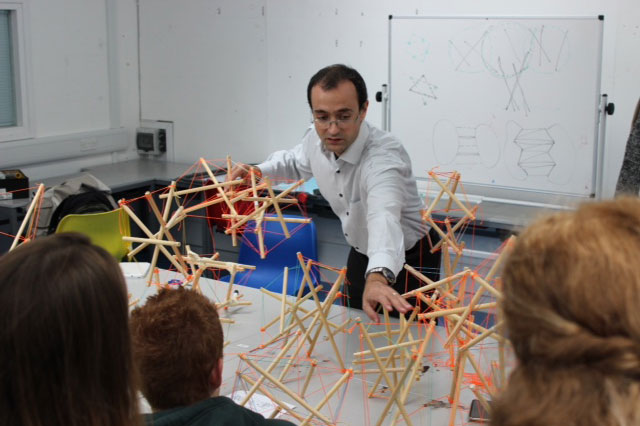
An iconic new sculpture marks both the University’s 50th anniversary and 10 years since the founding of Kent School of Architecture (KSA).
The Tensegritree, a tree-like structure between the Marlowe Building and new Templeman West building, has been created by an international team of architects and engineers led by KSA Head, Professor Don Gray.
The sculpture is one of 12 Beacon Projects, launched during Kent’s anniversary year to celebrate our successes over the last 50 years and look ahead to the next half-century.
Link with trees
The idea for the new structure dates back to plans for the extension of the Templeman Library by architects Penoyre and Prasad, which included a designated space for a sculpture.
Don Gray: ‘As the excavations for the library continued, it was clear that a number of trees were being removed (hence “Tensegritree”). This encouraged me to make a bid to produce something that marked the trees that had gone as well as celebrating both the University’s 50th and KSA’s 10th birthdays.’
A bid was made to the Beacon Projects team to create a tensegrity structure – the word “tensegrity” was first used by Buckminster Fuller in the 1960s to describe a type of structure which had a “tensional integrity”. Famous examples of tensegrity structures – sometimes referred to as “floating compression” structures – include Buckminster Fuller’s proposal for a tensegrity dome (1953) and Kenneth Snellson’s Dragon sculpture (2000/03).
Initial designs
The starting-point for the University’s Tensegritree structure was inviting world-leading tensegrity expert, Professor Andrea Micheletti to Kent. He worked alongside BA and MArch students of architecture at KSA to come up with a number of potential designs, before deciding on a central trunk with cantilevered tensegrity “branches”.
Professor Gray stresses that, from the beginning of the project, ‘Student involvement, learning and development, alongside the structural engineers and fabricators, was fundamental.’
The chosen design was subjected to a feasibility study conducted by Expedition Engineers (the team behind the London Olympic Velodrome) and tensegrity experts from the University of Cambridge.
Contractor ES Global was then appointed to develop the design, with the help of KSA specialists including its digital workshop team, who produced 3D images to perfect the joints of the new structure. The complex engineering of the structure led to it being featured at the Future Visions conference on Shell and Spatial structures in Amsterdam in August 2015.
Assembly of the structure took less than one week on site. The result , according to Don Gray, is ‘a truly ground-breaking adventure in high-technology assembly, the use of new materials and advanced structural engineering.’
Striking legacy
The striking Tensegritree was unveiled by the Vice-Chancellor on the eve of the 50th Festival celebrations from 4-6 September 2015. Standing at 7m high and 12m diameter, the structure comprises galvanised steel – for the compressive ‘strut’ elements – and stainless steel rods – for the tensile cable elements.
The final stage is to create a seating area on the compass points below the structure, to provide the best viewing-points for the tensegrity elements. The new seating, scheduled for spring 2016, will create a unique outdoor teaching space for staff, students and local school-children. The final design will be the result of an open competition sponsored by the University Creative Campus project
Don Gray: ‘The Tensegritree has the ability to intrigue, provoke and delight… In spite of the time and financial constraints, the new structure is already proving a striking feature, alongside other artworks dotted across the University’s campuses.
‘It will also ensure that the legacy of the University 50th birthday celebrations will be visible in the physical form of the tensegrity structure 50 years from now.’








